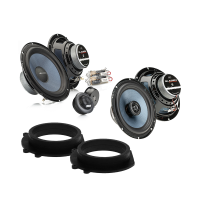Amplifier Audison AP 5.9 bit
5-channel amplifier with DSP processor, 2 x 20 + 2 x 50 + 1 x 150 into 4 Ω / 2 x 40 + 2 x 90 + 1 x 270 W RMS into 2 Ω
More about the product
More about the product
Audison AP 5.9 bit amplifier with built-in DSP processor
5-channel amplifier with an integrated 9-channel DSP processor. The AP5.9 bit amplifier is ideal for realizing a 2-way fully active system with a subwoofer using the fifth mono channel with 270 W into 2 Ω. The onboard processor that this amp shares with the AP8.9 bit provides the ability to assign pre-outputs to the AP4 D amp. Among the main features of the amplifier are "Full Digital Audio" - pure digital signal transmission with a resolution of up to 24 bit / 48 kHz and automatic tuning using Audison bit Tune and communication with the bit portal Drive. To speed up overall installation time with safety and reliability in mind, Audison's R&D team equipped Prima amplifiers with DCC ("Direct Current Cockpit"), an innovative control circuit that monitors current consumption in real time. This solution provides the possibility to connect the amplifier directly without draining the battery.| Catalog number | AP 5.9 BIT |
| Brand | Audison |
| Links | Official web presentation (English) |
| Number of amplifier channelsAmplifiers are divided into: - Monoblocks - 2-channel - 3-channel - 4-channel - 5-channel - 6-channel - multi-channel Each channel is used to power one speaker for the coaxial type, or one side if they are component speakers. Monoblock type amplifiers are mainly used for subwoofers. 2-channel are suitable for both subwoofers and, for example, the front pair of speakers in a car. 3-channel is used for front or rear speakers + subwoofer. 4-channel are used for front + rear speakers or 1 pair of speakers + subwoofer. 6 or 5-channel are used for 2 pairs of speakers + subwoofer, most often. Bridging means connecting the amplifier to a bridge, using the + pole from one channel and the - pole from the other channel. In most cases this is shown as "BRIDGED" on the amplifier. | 5 |
| Energy class of the amplifierAmplifiers are divided into two basic classes: analog and digital . Analog amplifiers (A/B) have higher consumption requirements, but usually have a more natural sound. Digital amplifiers (D) have significantly lower consumption and higher efficiency, but the sound may not be as faithful as with classic analog amplifiers. | D |
| RMS power into 4 ΩRMS power when loading speakers or subwoofer at 4 Ω. RMS power is the constant power of the amplifier and is one of the most important parameters when choosing an amplifier. | 2 x 20 + 2 x 50 + 1 x 150 W |
| RMS power into 2 ΩRMS power when loading speakers or subwoofer at 2 Ω. RMS power is the constant power of the amplifier and is one of the most important parameters when choosing an amplifier. | 2 x 40 + 2 x 90 + 1 x 270 W |
| Signal-to-noise ratioThe signal-to-noise ratio means that the output signal always contains noise. The signal-to-noise ratio expresses how much of this noise is compared to the useful signal. The so-called A value is given, which does not take deep and very high frequencies into account. This corresponds to the characteristic of human hearing, which is not so sensitive to deep frequencies, especially below 1 kHz. The higher the value, the better the amplifier is. | 95 dB |
| Input sensitivityIn order for the amplifier to perform its function correctly, it requires an input signal of a certain level, which is different for car radios. It is measured in "Volts" (e.g. 2 V, 4 V, etc.) The higher the value at the output of the pre-amplifier, or car radio, the less demands are placed on the power of the amplifier. However, the amplifier must allow this input sensitivity, and for that reason this value is also given for the amplifier. | 2 - 15 V |
| Phase shiftPhase shift is a linear electronic oscillator that produces a sinusoidal output. It consists of an inverting part of the amplifier such as a transistor. The feedback network "shifts" the phase at the output of the amplifier by 180 degrees to the oscillation frequency and gives positive feedback. The Phase shift filter produces a phase shift that increases with increasing frequency. This is usually used when the subwoofer sub-assembly is out with the magnet, or when two amplifiers are connected externally. Phase Shift is also used with active speaker wiring, where the time shift of the speakers is set. The point is that the subwoofer does not play the bass late, and for this reason better amplifiers offer this phase reversal option. | 0° / 180° |
| Damping factorDF - Damping Factor . It is the ratio of the load (repro + cables, crossover, etc.) to the internal resistance of the amplifier. The bigger the DF, the more controlled the bass. Amplifiers with a lower DF tend to hum. Subwoofers with a higher Q in the bass reflex and sometimes in the enclosure will also cause humming. | > 70 |
| Socket input terminalsFerrule terminals allow better wiring contact to the amplifier. It is also a more secure form of terminals. If you are tightening the sleeve terminals, we recommend retightening them after 1 day, as the connected cable gradually compresses. | Yes |
| Dimensions of the amplifier | 198 x 45.50 x 134 mm |
| Mass | 1.5 kg |
| Other | 1 x micro USB-B |
Product comments
Evaluation
ask us
























